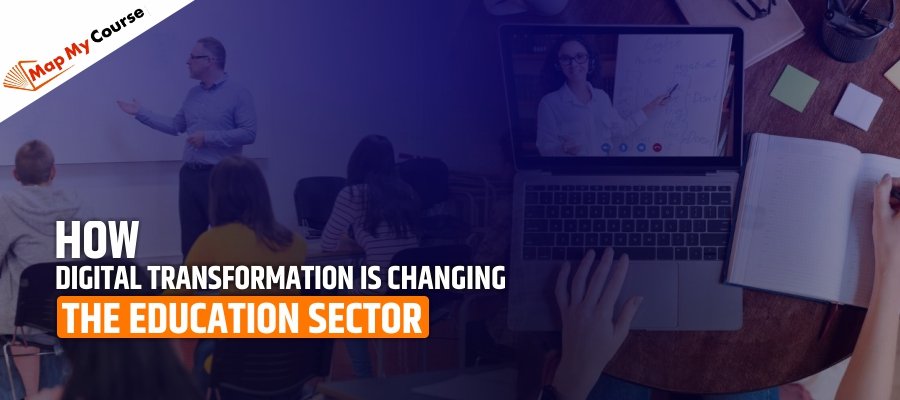Let’s be real, education isn’t the same anymore! The days of just books and blackboards are gone. Digital transformation has completely changed how we learn.
Now, students can attend classes online, use smart study tools, and access unlimited resources anytime, anywhere. It’s like No more boring lectures and learning is now faster, easier, and way more fun.
In this guide by MapMyCourse, we’ll get into How Digital Transformation Is Changing the Education Sector and why it’s making learning better for everyone.
What Is Digital Transformation In Education Sector?
Digital transformation in education is simply means using technology to improve learning. It’s not just about online classes it includes smart classrooms, e-books, AI-based learning tools, and even virtual reality for interactive lessons.
From schools to universities, everything is becoming digital. Teachers can now track student progress online, and students can learn at their own pace using mobile apps and educational platforms. This shift is making education more accessible, flexible, and engaging for everyone.
Benefits Of Digtal Transformation In Education Sector
Here are some of the benefits of digital transformation in education sector are:
- Learn Anytime, Anywhere: No more rigid schedules! Students can study from home, while traveling, or even during a break. Online classes and recorded lectures make learning super flexible.
- More Affordable Education: Digital learning cuts costs on books, travel, and even tuition fees. Many courses are free or cheaper, making education accessible to more students.
- Personalized Learning: Everyone learns at their own pace. Digital tools let students speed up or slow down lessons based on their understanding, making learning more effective.
- Interactive and Engaging Lessons: Forget boring textbooks! Videos, animations, and gamified lessons make learning fun and easier to grasp.
- Global Learning Opportunities: Students can take courses from top universities and industry experts worldwide, expanding their knowledge beyond local institutions.
- Faster Skill Updates: Education evolves quickly! Digital platforms keep students updated with the latest knowledge and industry trends.
- Better Collaboration: Virtual classrooms, discussion forums, and online group projects make it easier for students and teachers to stay connected and share knowledge.
- Smart Learning with Data: AI-powered platforms track student progress and provide personalized feedback, helping them improve faster.
How Digital Transformation Is Changing The Education Sector
Education is no longer limited to classrooms with chalkboards and heavy books. Thanks to digital transformation, learning has now become smarter, faster, and more accessible for students everywhere. Here’s how:
1. Smart Technology in Classrooms
The days of plain blackboards and chalk dust are gone! Schools and colleges now use smart boards, digital tools, and even AI to make learning more interactive and engaging. Instead of just listening to lectures, students can watch videos, do quizzes, and even use simulations to understand complex topics better.
2. Learn Anytime, Anywhere
No need to be in a classroom to learn! With online platforms like Coursera, Udemy, and Khan Academy, students and working professionals can take courses whenever and wherever they want. Whether it’s at home, while traveling, or even during a lunch break, education is now just a few clicks away.
3. Education for Everyone
Many students, especially those in villages or remote areas, struggle to access quality education due to distance and lack of resources. Digital learning removes these barriers, allowing students from anywhere to attend online classes, watch lectures, and complete assignments without having to move to big cities.
4. Learning at Your Own Speed
Not everyone understands things at the same pace. AI-powered learning platforms analyse a student’s progress and suggest lessons based on their learning speed. This means students can spend more time on tough topics and move quickly through easier ones, making learning more effective and less stressful.
5. No More Heavy Books
Forget carrying huge textbooks every day! Now, students can use e-books, PDFs, and online notes to study. Digital learning is not only cheaper (since you don’t need to buy physical books) but also eco-friendly, saving tons of paper every year. Plus, you can store everything on your phone or laptop, making it super convenient.
6. Live and Recorded Classes
Missed an important lecture? No worries! Many online platforms offer both live and recorded classes, so students can revisit lessons anytime. This is especially helpful for working professionals who may not have time to attend live classes every day.
7. Upgrade Your Skills without Quitting Your Job
Whether you’re a college student looking to learn something new or a professional wanting to boost your career, online courses make it easy to gain new skills. You can get certifications, switch careers, or even get promotions while continuing with your regular job.
8. Better Interaction with Teachers
Sometimes, asking questions in class can be scary. But with video calls, discussion forums, and AI chatbots, students can easily ask doubts, discuss topics, and get instant help from teachers or experts without hesitation.
9. Instant Feedback on Exams
No more waiting for weeks to get your exam results! Online tests provide instant feedback, so students know where they are doing well and what areas need improvement right away. This makes learning more efficient and goal-oriented.
10. Mix of Online and Offline Learning
Many schools and colleges now use a blended learning model, where students learn partly online and partly in classrooms. This combines the best of both world’s face to face interaction with teachers and the flexibility of digital learning.
Common Problems In Digital Education And Solutions
Digital learning is great, but it also comes with some challenges. Here are a few common problems and how they can be fixed:
- No Internet or Devices – Many students don’t have a good internet connection or a laptop/mobile, making it hard to attend online classes.
Solution: Governments and schools can provide low-cost devices and free internet access in schools or learning centres.
- Too Many Distractions – Social media, games, and TV make it hard to focus on online studies.
Solution: Students can use focus apps like Stay Focused or study in a quiet place to avoid distractions.
- No Face-to-Face Interaction – Online learning can feel lonely without classmates and teachers around.
Solution: Schools can use video calls, group projects, and discussion forums to help students connect.
- Hard to Understand Some Subjects – Practical subjects like science and math are difficult to grasp without real-life experiments.
Solution: Schools can use virtual labs, animations, and interactive tools to explain concepts better.
- Technical Issues – Slow internet, app crashes, and login problems interrupt learning.
Solution: Schools should use reliable learning platforms and provide basic tech support for students.
- Teachers Struggling with Online Teaching – Some teachers are not familiar with digital tools and find online teaching difficult.
Solution: Schools should provide training sessions for teachers on how to use digital platforms effectively.
- Cheating in Online Exams – It’s easier for students to cheat during online tests.
Solution: Schools can use AI-based monitoring tools and set more practical, open-book exams to encourage real learning.
How Digital Learning Is Helping More Students To Get Education
Digital learning makes education more easy and flexible for everyone. Students can learn from home, save money, and study anytime. It helps those in remote areas and offers many course options, making learning available for everyone. Here are some key points of it:
- Reaches Remote Areas: Students in villages and small towns can now access quality education without traveling long distances. Online classes bring learning right to their homes.
- More Affordable: Digital education cuts down costs on books, transport, and tuition. Many online courses are free or available at low prices, making learning more budget-friendly.
- Flexible Learning: Not everyone can attend fixed-time classes. Online education allows students to study whenever they want, making it easier for working students and busy individuals.
- Helps Disabled Students: Students with physical disabilities can learn comfortably from home using digital tools like screen readers and speech-to-text software.
- No Age Limit: Learning isn’t just for kids and teenagers. Adults can up skill, switch careers, or complete their education anytime with online courses.
- More Course Choices: Schools have limited subjects, but online platforms offer everything from coding to business, photography to design—students can learn what interests them.
Future Of Education In Digital Age
As you know that, the future of education is changing fast! Learning is no longer just about sitting in a classroom with books. With online platforms, AI tutors, and even virtual reality, students can now study from anywhere and at their own pace. Schools and colleges are using smart technology to make lessons more engaging and personalized.
Teachers can track progress better and help students in real time. More people, even those in remote areas, can now access quality education. As technology keeps growing, education will become even more flexible, interactive, and accessible for everyone.
Some Ways Digital Transformation Is Changing Education
So, here are some ways digital transformation is changing in education are:
- Smart classrooms now use digital tools like smart boards and AI, making lessons more engaging and interactive.
- Online learning allows students to study from anywhere, removing the need to travel long distances.
- AI-powered platforms help students learn at their own pace by suggesting lessons based on their progress.
- Digital education makes it possible for students in remote areas to access quality learning resources.
- Recorded lectures give students the flexibility to revisit lessons whenever they need.
- E-books and online study materials replace heavy textbooks, making learning more convenient and affordable.
- Online platforms make it easier for students to ask doubts and interact with teachers through video calls and chat forums.
- Instant feedback on online exams helps students quickly understand their mistakes and improve.
- Many schools now use a mix of online and offline learning, providing a more balanced and effective education system.
Here are some blogs
Conclusion
Well, digital transformation has completely changed how we learn, right? No more being stuck with heavy books or long travels. Education is now at your fingertips whether you’re a student, a working professional, or just someone eager to learn, there are endless options for you. The key is to make the most of the technology available, stay curious, and keep learning at your own space. Education is no longer limited to classrooms it’s everywhere, and it’s for everyone. Hope this blog clarify everything.
FAQs
Q1. What is digital learning?
Ans:Digital learning uses technology like online courses, apps, and virtual classrooms to make education more accessible.
Q2. How does digital learning help students?
Ans:It lets students learn anytime, anywhere, at their own pace, making education more flexible and convenient.
Q3. Is online education cheaper than traditional education?
Ans:Yes, it saves money on travel, books, and even tuition fees in many cases.
Q4. Can digital learning replace regular schools?
Ans:Not completely, but it enhances learning by offering more resources and flexibility.
Q5. Do employers accept online degrees?
Ans:Yes, as long as they’re from recognized platforms or universities.

















